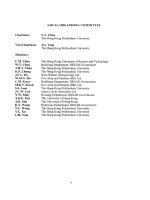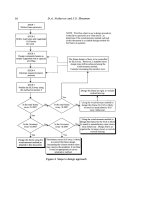CONNECTIONS IN STEEL STRUCTURES
Bạn đang xem bản rút gọn của tài liệu. Xem và tải ngay bản đầy đủ của tài liệu tại đây (2.29 MB, 23 trang )
CONNECTIONS
IN STEEL
STRUCTURES
By: Naveed Ahmad
2005-MS-STR-C-86
CONNECTION
Connections are the devises which are used to join elements of a
structure together at a point such that forces can be transferred
between them safely.
TYPES OF CONNECTIONS
BASED ON MEANS OF CONNECTION
WELDED CONNECTIONS
RIVITED CONNECTIONS
BOLTED CONNECTIONS
BASED ON FORCES TO BE TRANSFERED
TRUSS CONNECTIONS
FULLY RESTRAINED CONNECTONS
PARTIALLY RESTRAINED CONNECTIONS
SPLICES
BARCKETS
BASED ON PLACEMENT OF PARTS TO BE JOINED
LAP JOINTS
BUTT JOINTS
TRUSS CONNECTIONS
In truss connections only the axial forces are to be
transferred. These are simplest in all types of connections
which may either be welded or bolted.
FULLY RESTRAINED/MOMENT CONNECTIONS
These connections are particularly used when
continuity between the members of the building
frame is required to provide more flexural resistance
and reduce lateral deflection due to wind loads. In
this type of connection both the webs and flanges
are connected. In this connection greater than 90%
moment can be transferred with full transfer of
shear and other forces
PARTIALLY RESTRAINED CONNECTIONS
These connections have rigidity less than 90%. The
original angles between the connected members may
change up to a certain limit after the application of
loads.
These
connections
can
transfer
some
percentage of moment along with full shear force.
SIMPLE\SHEAR CONNECTIONS
These connections have less than 20% rigidity. These
are considered flexible and beams become simply
supported. In this case only the web is connected with
the other member because most of shear stresses are
concentrated in the web.
SEMI-RIGID CONNECTIONS
These types of connections provide rigidity in
between fully restrained and simple connections and
approximately 20% to 90% moment compared with
ideal rigid joint may be transferred. These type of
connections are mostly used in practice because
their performance is exceptionally well under cyclic
loads and earthquakes
SPLICES
These are used to extend the length of a particular
member. These connections may be bolted or welded.
BRACKETS
These are the connections which used to transfer
moment besides other type of forces. The term
bracket is generally used for an extra plate
projecting out of column and acting like a seat for
the beam.
COLUMN BASE CONNECTIONS
These connections can either be pined or fixed depending
upon the type of forces to be transferred.









